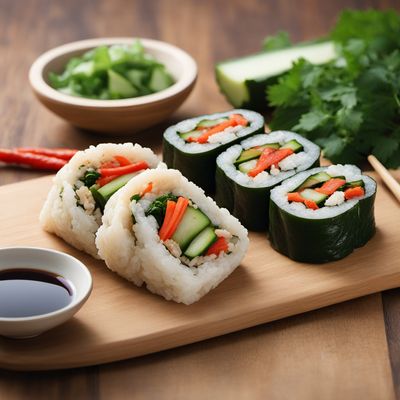
Recipe
Indonesian-style Boribap with Spicy Peanut Sauce
Nasi Boribap: A Fusion of Korean and Indonesian Flavors
4.5 out of 5
Indonesian-style Boribap is a delightful fusion dish that combines the traditional Korean Boribap with the vibrant flavors of Indonesian cuisine. This recipe brings together the nutty and savory Boribap rice bowl with a spicy peanut sauce, creating a unique and delicious culinary experience.
Metadata
Preparation time
20 minutes
Cooking time
10 minutes
Total time
30 minutes
Yields
4 servings
Preparation difficulty
Easy
Suitable for
Vegetarian, Vegan, Gluten-free, Dairy-free, Nut-free
Allergens
Peanuts, Soy
Not suitable for
Paleo, Keto, Low-carb, High-protein, Atkins
Ingredients
In this Indonesian adaptation of Boribap, we incorporate Indonesian flavors and ingredients to give the dish a unique twist. The original Korean Boribap typically uses soy sauce and sesame oil for seasoning, while our Indonesian-style Boribap incorporates ingredients like kecap manis (sweet soy sauce), sambal (chili paste), and peanuts to create a spicy peanut sauce. This fusion of flavors adds a delightful Indonesian touch to the traditional Korean dish. We alse have the original recipe for Boribap, so you can check it out.
-
2 cups (400g) cooked rice 2 cups (400g) cooked rice
-
1 carrot, julienned 1 carrot, julienned
-
1 cup (150g) mushrooms, sliced 1 cup (150g) mushrooms, sliced
-
2 cups (60g) spinach 2 cups (60g) spinach
-
200g tofu, cubed 200g tofu, cubed
-
2 tablespoons vegetable oil 2 tablespoons vegetable oil
-
2 tablespoons kecap manis (sweet soy sauce) 2 tablespoons kecap manis (sweet soy sauce)
-
2 tablespoons sambal (chili paste) 2 tablespoons sambal (chili paste)
-
1/4 cup (30g) peanuts, crushed 1/4 cup (30g) peanuts, crushed
-
Salt, to taste Salt, to taste
Nutrition
- Calories (kcal / KJ): 350 kcal / 1465 KJ
- Fat (total, saturated): 12g, 2g
- Carbohydrates (total, sugars): 50g, 10g
- Protein: 10g
- Fiber: 5g
- Salt: 1g
Preparation
-
1.Heat vegetable oil in a pan over medium heat. Add carrots, mushrooms, and tofu. Sauté until vegetables are tender.
-
2.Add spinach to the pan and cook until wilted. Season with salt.
-
3.In a separate bowl, mix kecap manis, sambal, and crushed peanuts to make the spicy peanut sauce.
-
4.Add cooked rice to the pan with the vegetables and tofu. Stir well to combine.
-
5.Serve the Boribap in bowls, topped with the spicy peanut sauce.
Treat your ingredients with care...
- Tofu — Press the tofu before cubing it to remove excess moisture and enhance its texture.
- Mushrooms — Use a mix of different mushrooms like shiitake, oyster, or cremini for a more complex flavor profile.
- Spinach — Blanch the spinach in boiling water for a minute before adding it to the dish to retain its vibrant green color.
- Peanuts — Roast the peanuts before crushing them to intensify their flavor.
- Kecap Manis — If you can't find kecap manis, you can substitute it with a mixture of soy sauce and brown sugar.
Tips & Tricks
- Customize the spiciness of the peanut sauce by adjusting the amount of sambal according to your preference.
- Add a squeeze of lime juice to the peanut sauce for a tangy twist.
- Garnish the Boribap with chopped scallions or cilantro for added freshness.
- Experiment with different vegetables like bell peppers or bean sprouts to add more variety to the dish.
- Serve the Boribap with a side of Indonesian pickles (acar) for a refreshing contrast.
Serving advice
Serve the Indonesian-style Boribap hot in individual bowls, allowing each person to drizzle the spicy peanut sauce over their portion. Accompany it with a side of Indonesian pickles and enjoy the vibrant flavors and textures of this fusion dish.
Presentation advice
For an appealing presentation, arrange the colorful vegetables and tofu on top of the rice in an organized manner. Drizzle the spicy peanut sauce over the ingredients, allowing it to cascade down the sides of the bowl. Garnish with a sprinkle of crushed peanuts and a sprig of fresh herbs.
More recipes...
For Korean cuisine » Browse all
For Indonesian cuisine » Browse all
More Korean cuisine dishes » Browse all

Galbitang
Beef short rib soup
Galbitang is a Korean beef short rib soup that is hearty and comforting. It is a popular dish in Korea, especially during the winter months.

Dwaeji gukbap
Pork soup with rice
Dwaeji gukbap is a traditional Korean soup that is made with pork and rice. It is known for its hearty flavor and warming properties, and is often...

Buseot bokkeum
Spicy Mushroom Stir-Fry
Buseot bokkeum is a Korean stir-fry dish made with mushrooms and a spicy sauce. It is a popular dish in Korea and is often served as a side dish...
More Indonesian cuisine dishes » Browse all

Ayam goreng
Fried Chicken
Ayam goreng is a popular Indonesian dish that translates to "fried chicken" in English. It is a simple yet flavorful dish that is loved by many.

Sate Padang
Padang Satay
Sate Padang is an Indonesian dish made with beef or chicken skewers that are marinated in a spicy sauce and grilled. It is typically served with...

Klepon
Klepon is a traditional Indonesian sweet treat that is made from glutinous rice flour and palm sugar. It has a chewy texture and a sweet, coconut flavor.







